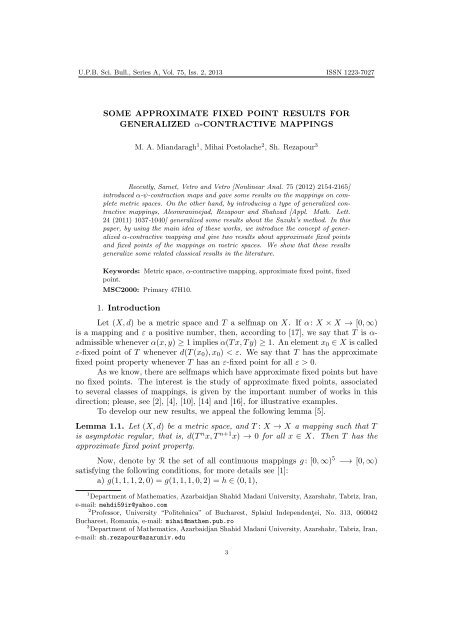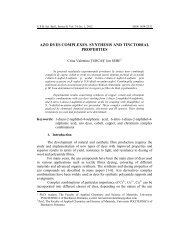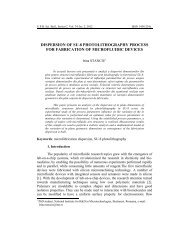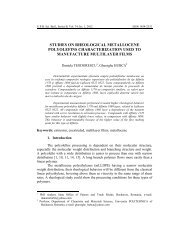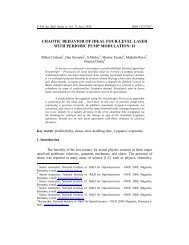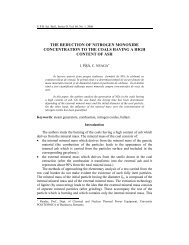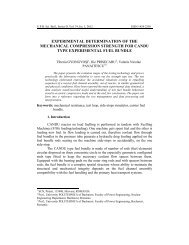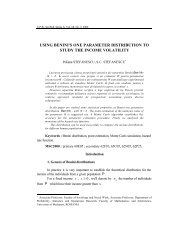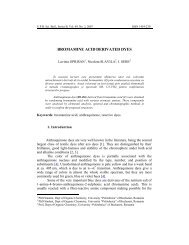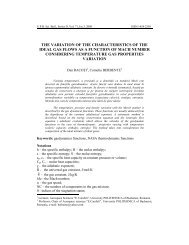(X, d) be a metric space and T - Scientific Bulletin
(X, d) be a metric space and T - Scientific Bulletin
(X, d) be a metric space and T - Scientific Bulletin
You also want an ePaper? Increase the reach of your titles
YUMPU automatically turns print PDFs into web optimized ePapers that Google loves.
U.P.B. Sci. Bull., Series A, Vol. 75, Iss. 2, 2013 ISSN 1223-7027<br />
SOME APPROXIMATE FIXED POINT RESULTS FOR<br />
GENERALIZED α-CONTRACTIVE MAPPINGS<br />
M. A. Mi<strong>and</strong>aragh 1 , Mihai Postolache 2 , Sh. Rezapour 3<br />
Recently, Samet, Vetro <strong>and</strong> Vetro [Nonlinear Anal. 75 (2012) 2154-2165]<br />
introduced α-ψ-contraction maps <strong>and</strong> gave some results on the mappings on complete<br />
<strong>metric</strong> <strong>space</strong>s. On the other h<strong>and</strong>, by introducing a type of generalized contractive<br />
mappings, Aleomraninejad, Rezapour <strong>and</strong> Shahzad [Appl. Math. Lett.<br />
24 (2011) 1037-1040] generalized some results about the Suzuki’s method. In this<br />
paper, by using the main idea of these works, we introduce the concept of generalized<br />
α-contractive mapping <strong>and</strong> give two results about approximate fixed points<br />
<strong>and</strong> fixed points of the mappings on <strong>metric</strong> <strong>space</strong>s. We show that these results<br />
generalize some related classical results in the literature.<br />
Keywords: Metric <strong>space</strong>, α-contractive mapping, approximate fixed point, fixed<br />
point.<br />
MSC2000: Primary 47H10.<br />
1. Introduction<br />
Let (X, d) <strong>be</strong> a <strong>metric</strong> <strong>space</strong> <strong>and</strong> T a selfmap on X. If α: X × X → [0, ∞)<br />
is a mapping <strong>and</strong> ε a positive num<strong>be</strong>r, then, according to [17], we say that T is α-<br />
admissible whenever α(x, y) ≥ 1 implies α(T x, T y) ≥ 1. An element x 0 ∈ X is called<br />
ε-fixed point of T whenever d(T (x 0 ), x 0 ) < ε. We say that T has the approximate<br />
fixed point property whenever T has an ε-fixed point for all ε > 0.<br />
As we know, there are selfmaps which have approximate fixed points but have<br />
no fixed points. The interest is the study of approximate fixed points, associated<br />
to several classes of mappings, is given by the important num<strong>be</strong>r of works in this<br />
direction; please, see [2], [4], [10], [14] <strong>and</strong> [16], for illustrative examples.<br />
To develop our new results, we appeal the following lemma [5].<br />
Lemma 1.1. Let (X, d) <strong>be</strong> a <strong>metric</strong> <strong>space</strong>, <strong>and</strong> T : X → X a mapping such that T<br />
is asymptotic regular, that is, d(T n x, T n+1 x) → 0 for all x ∈ X. Then T has the<br />
approximate fixed point property.<br />
Now, denote by R the set of all continuous mappings g : [0, ∞) 5 −→ [0, ∞)<br />
satisfying the following conditions, for more details see [1]:<br />
a) g(1, 1, 1, 2, 0) = g(1, 1, 1, 0, 2) = h ∈ (0, 1),<br />
1 Department of Mathematics, Azarbaidjan Shahid Madani University, Azarshahr, Tabriz, Iran,<br />
e-mail: mehdi59ir@yahoo.com<br />
2 Professor, University “Politehnica” of Bucharest, Splaiul Independenţei, No. 313, 060042<br />
Bucharest, Romania, e-mail: mihai@mathem.pub.ro<br />
3 Department of Mathematics, Azarbaidjan Shahid Madani University, Azarshahr, Tabriz, Iran,<br />
e-mail: sh.rezapour@azaruniv.edu<br />
3
4 M. A. Mi<strong>and</strong>aragh, Mihai Postolache, Sh. Rezapour<br />
b) g(αx 1 , αx 2 , αx 3 , αx 4 , αx 5 ) ≤ αg(x 1 , x 2 , x 3 , x 4 , x 5 ), for all (x 1 , x 2 , x 3 , x 4 , x 5 )<br />
in [0, ∞) 5 <strong>and</strong> α ≥ 0,<br />
c) if x i , y i ∈ [0, ∞) <strong>and</strong> x i < y i for i = 1, . . . , 4, then<br />
g(x 1 , x 2 , x 3 , x 4 , 0) < g(y 1 , y 2 , y 3 , y 4 , 0), g(x 1 , x 2 , x 3 , 0, x 4 ) < g(y 1 , y 2 , y 3 , 0, y 4 ).<br />
This class of mappings has the property in Proposition 1.1, see [1] <strong>and</strong> Lemma<br />
1.3 in [9], which is necessary for developing our new results.<br />
Proposition 1.1. If g ∈ R <strong>and</strong> u, v ∈ [0, ∞) are such that<br />
u ≤ max{g(v, v, u, v + u, 0), g(v, v, u, 0, v + u), g(v, u, v, v + u, 0), g(v, u, v, 0, v + u)},<br />
then u ≤ hv.<br />
Now, we are ready to state <strong>and</strong> prove our main results.<br />
2. Main Results<br />
First, by using the main idea of [1] <strong>and</strong> [17], we introduce the notion of generalized<br />
α-contractive mapping. In this respect, we emphasize that throughout<br />
this paper we suppose that (X, d) is a <strong>metric</strong> <strong>space</strong>, T is a selfmap on X <strong>and</strong><br />
α: X × X → [0, ∞) is a mapping.<br />
We say that the selfmap T of X is a generalized α-contractive mapping whenever<br />
there exists g ∈ R such that<br />
for all x, y ∈ X.<br />
α(x, y)d(T x, T y) ≤ g(d(x, y), d(x, T x), d(y, T y), d(x, T y), d(y, T x)),<br />
Theorem 2.1. Let (X, d) <strong>be</strong> a <strong>metric</strong> <strong>space</strong> <strong>and</strong> T a generalized α-contractive <strong>and</strong><br />
an α-admissible selfmap on X such that α(x 0 , T x 0 ) ≥ 1, for some x 0 ∈ X. Then T<br />
has an approximate fixed point.<br />
Proof. Fix 1 > r > h <strong>and</strong> x 0 ∈ X such that α(x 0 , T x 0 ) ≥ 1. Define the sequence<br />
{x n } by x n+1 = T n+1 x 0 for all n ≥ 0.<br />
If x n = x n+1 , for some n, then we have nothing to prove.<br />
Assume that x n ≠ x n+1 for all n ≥ 0. Since T is α-admissible, it is easy to<br />
check that α(x n , x n+1 ) ≥ 1 for all n.<br />
Since<br />
d(x 1 , x 2 ) = d(T x 0 , T x 1 ) ≤ α(x 0 , x 1 )d(T x 0 , T x 1 )<br />
≤ g(d(x 0 , x 1 ), d(x 1 , T x 1 ), d(x 0 , T x 0 ), d(x 0 , T x 1 ), d(x 1 , T x 0 ))<br />
≤ g(d(x 0 , x 1 ), d(x 1 , x 2 ), d(x 0 , x 1 ), d(x 0 , x 1 ) + d(x 1 , x 2 ), 0),<br />
by using Proposition 1.1, we obtain d(x 1 , x 2 ) ≤ hd(x 0 , x 1 ) < rd(x 0 , x 1 ).<br />
Since<br />
d(x 2 , x 3 ) = d(T x 1 , T x 2 ) ≤ α(x 1 , x 2 )d(T x 1 , T x 2 )<br />
≤ g(d(x 1 , x 2 ), d(x 2 , T x 2 ), d(x 1 , T x 1 ), d(x 1 , T x 2 ), d(x 2 , T x 1 ))<br />
≤ g(d(x 1 , x 2 ), d(x 2 , x 3 ), d(x 1 , x 2 ), d(x 1 , x 2 ) + d(x 2 , x 3 ), 0),<br />
again by using Proposition 1.1, we obtain<br />
d(x 2 , x 3 ) ≤ hd(x 1 , x 2 ) < rd(x 1 , x 2 ) < r 2 d(x 0 , x 1 ).
Some approximate fixed point results for generalized α-contractive mappings 5<br />
By continuing this process, we obtain d(x n , x n+1 ) < r n d(x 0 , x 1 ) for all n.<br />
Hence, d(T n+1 x 0 , T n x 0 ) → 0, <strong>and</strong> from Lemma 1.1, we conclude that T has the<br />
approximate fixed point property.<br />
□<br />
The following example shows that there are generalized α-contractive selfmaps<br />
on non-complete <strong>metric</strong> <strong>space</strong>s, satisfying Theorem 2.1, which have no fixed point<br />
while have approximate fixed points.<br />
Example 2.1. Let X = (0, 1), d(x, y) = |x−y| <strong>and</strong> α(x, y) = 1 whenever x 2 = y <strong>and</strong><br />
α(x, y) = 1<br />
20 otherwise. Define the selfmap T on X by T x = x2 for all x ∈ X. Also,<br />
define g ∈ R by g(x 1 , x 2 , x 3 , x 4 , x 5 ) = 9 20 (x 2 +x 3 ). Then, it is easy to check that T is<br />
generalized α-contractive <strong>and</strong> α-admissible selfmap on X such that α(x 0 , T x 0 ) ≥ 1<br />
for x 0 = 1 2 .<br />
The following corollaries show us that there are different types of generalized<br />
α-contractive mappings satisfying Theorem 2.1. One can provide many examples<br />
for each type of such mappings. We shall provide some examples for each type of<br />
the maps but one could provide more examples.<br />
Corollary 2.1. Let (X, d) <strong>be</strong> a complete <strong>metric</strong> <strong>space</strong> <strong>and</strong> T a continuous, generalized<br />
α-contractive <strong>and</strong> α-admissible selfmap on X such that α(x 0 , T x 0 ) ≥ 1, for<br />
some x 0 ∈ X. Then T has a fixed point.<br />
Proof. By using a similar argument in proof of Theorem 2.1, we obtain<br />
d(x n , x n+1 ) ≤ hd(x n−1 , x n ) < rd(x n−1 , x n ) < r n d(x 0 , x 1 ),<br />
for all n. If suppose m < n, then it is easy to see that<br />
d(x m , x n ) ≤ (r m + r m+1 + · · · + r n−1 )d(x 0 , x 1 ) <<br />
rm<br />
1 − r d(x 0, x 1 ).<br />
Thus, {x n } is a Cauchy sequence. Since (X, d) is complete, there exists x ∗ ∈ X such<br />
that x n → x ∗ . Moreover, T is continuous, T x n → T x ∗ <strong>and</strong> so T x ∗ = x ∗ . □<br />
As we know, Banach proved his contraction principle result in 1922; please,<br />
see [3]. Following this direction, we say that the selfmap T is α-contractive whenever<br />
exists λ ∈ (0, 1) such that α(x, y)d(T x, T y) ≤ λd(x, y) for all x, y ∈ X.<br />
Corollary 2.2. Let (X, d) <strong>be</strong> a <strong>metric</strong> <strong>space</strong> <strong>and</strong> T an α-contractive <strong>and</strong> α-admissible<br />
selfmap on X such that α(x 0 , T x 0 ) ≥ 1 for some x 0 ∈ X. Then T has the approximate<br />
fixed point property.<br />
Proof. Consider g ∈ R given by g(x 1 , x 2 , x 3 , x 4 , x 5 ) = λx 1 . Then, T is a generalized<br />
α-contractive <strong>and</strong> α-admissible selfmap on X such that α(x 0 , T x 0 ) ≥ 1, for some<br />
x 0 ∈ X. Hence by Theorem 2.1, T has the approximate fixed point property. □<br />
In 2011, Haghi, Rezapour <strong>and</strong> Shahzad proved that some fixed point generalizations<br />
are not real generalizations [11]. The following example shows that these<br />
results are real ones.<br />
Example 2.2. Let X = [0, ∞) <strong>and</strong> d(x, y) = |x − y|. Define the selfmap T on X<br />
by T x = 4 3 x for all x ∈ X <strong>and</strong> put λ = 1 2<br />
. Then, the selfmap T is not contractive.<br />
Let λ ∈ [0, 1). Define α(x, y) = µ for all x, y ∈ X, where µ ≤ 3λ 4<br />
. It is easy to see<br />
that T is α-contractive.
6 M. A. Mi<strong>and</strong>aragh, Mihai Postolache, Sh. Rezapour<br />
In 1968, the notion of Kannan-contraction is introduced by Kannan [13]. Now,<br />
we say that the selfmap T on a <strong>metric</strong> <strong>space</strong> is α-Kannan mapping whenever there<br />
exists β ∈ (0, 1 2<br />
) such that α(x, y)d(T x, T y) ≤ β(d(x, T x)+d(y, T y)) for all x, y ∈ X.<br />
Corollary 2.3. Let (X, d) <strong>be</strong> a <strong>metric</strong> <strong>space</strong> <strong>and</strong> T an α-Kannan <strong>and</strong> α-admissible<br />
selfmap on X such that α(x 0 , T x 0 ) ≥ 1, for some x 0 ∈ X. Then T has the approximate<br />
fixed point property.<br />
Proof. Consider g ∈ R by the formula g(x 1 , x 2 , x 3 , x 4 , x 5 ) = β(x 2 +x 3 ). Then, T is a<br />
generalized α-contractive <strong>and</strong> α-admissible selfmap on X such that α(x 0 , T x 0 ) ≥ 1<br />
for some x 0 ∈ X. By Theorem 2.1, T has the approximate fixed point property. □<br />
Corollary 2.4. Let (X, d) <strong>be</strong> a complete <strong>metric</strong> <strong>space</strong> <strong>and</strong> T a continuous, α-<br />
Kannan <strong>and</strong> α-admissible selfmap on X such that α(x 0 , T x 0 ) ≥ 1, for some x 0 ∈ X.<br />
Then T has a fixed point.<br />
Proof. Define g ∈ R by g(x 1 , x 2 , x 3 , x 4 , x 5 ) = β(x 2 + x 3 ). Then, by using Corollary<br />
2.1, it follows that T has a fixed point. □<br />
The following example shows that there exist α-Kannan mappings which are<br />
not Kannan maps.<br />
Example 2.3. Let X = [0, ∞) <strong>and</strong> d(x, y) = |x − y|. Define the selfmap T on X by<br />
T x = 5 4 x for all x ∈ X. Put β = 1 1<br />
4<br />
<strong>and</strong> α(x, y) = µ for all x, y ∈ X, where µ ≤<br />
20 .<br />
Then, it is easy to check that the selfmap T is not Kannan map whereas T is an<br />
α-Kannan map.<br />
In 1972, the notion of Chatterjea-contraction is introduced by Chatterjea in [8].<br />
Now, we say that the selfmap T is α-Chatterjea mapping whenever exists β ∈ (0, 1 2 )<br />
such that α(x, y)d(T x, T y) ≤ β(d(x, T y) + d(y, T x)) for all x, y ∈ X.<br />
Corollary 2.5. Let (X, d) <strong>be</strong> a <strong>metric</strong> <strong>space</strong>, T an α-Chatterjea <strong>and</strong> α-admissible<br />
selfmap on X such that α(x 0 , T x 0 ) ≥ 1, for some x 0 ∈ X. Then T has the approximate<br />
fixed point property.<br />
Proof. Let g ∈ R given by the formula g(x 1 , x 2 , x 3 , x 4 , x 5 ) = β(x 4 + x 5 ). Then, T is<br />
a generalized α-contractive <strong>and</strong> α-admissible selfmap on X such that α(x 0 , T x 0 ) ≥ 1<br />
for some x 0 ∈ X. Hence by using Theorem 2.1, T has the approximate fixed point<br />
property.<br />
□<br />
Next corollary generalizes the results in the literature about fixed point of<br />
Chatterjea selfmaps.<br />
Corollary 2.6. Let (X, d) <strong>be</strong> a complete <strong>metric</strong> <strong>space</strong> <strong>and</strong> T a continuous, α-<br />
Chatterjea <strong>and</strong> α-admissible selfmap on X such that α(x 0 , T x 0 ) ≥ 1, for some<br />
x 0 ∈ X. Then T has a fixed point.<br />
Proof. Define g ∈ R by g(x 1 , x 2 , x 3 , x 4 , x 5 ) = β(x 4 + x 5 ). Then by using Corollary<br />
2.1, T has a fixed point. □<br />
The following example shows that there exist α-Chatterjea mappings which<br />
are not Chatterjea selfmaps.
Some approximate fixed point results for generalized α-contractive mappings 7<br />
Example 2.4. Let X = [0, ∞) <strong>and</strong> d(x, y) = |x − y|. Define the selfmap T on X by<br />
T x = 4 3 x for all x ∈ X. For each β ∈ (0, 1 2 ), put x = β <strong>and</strong> y = 3 4β. Then, it is easy<br />
to see that T is not a Chatterjea mapping. If we put β = 1 4<br />
<strong>and</strong> define α(x, y) = µ<br />
for all x, y ∈ X, where µ ≤ 3<br />
80<br />
, then one can easily check that T is an α-Chatterjea<br />
selfmap.<br />
In 1972, the notion of Zamfirescu-contraction is introduced by Zamfirescu in<br />
[18]. Now, we say that the selfmap T is α-Zamfirescu mapping whenever exists<br />
β ∈ (0, 1) such that α(x, y)d(T x, T y) ≤ βM T (x, y) for all x, y ∈ X, where<br />
M T (x, y) = max{d(x, y), 1 2 [d(x, T y) + d(y, T x)], 1 [d(x, T x) + d(y, T y)]}.<br />
2<br />
Corollary 2.7. Let (X, d) <strong>be</strong> a <strong>metric</strong> <strong>space</strong> <strong>and</strong> T an α-Zamfirescu <strong>and</strong> α-admissible<br />
selfmap on X such that α(x 0 , T x 0 ) ≥ 1, for some x 0 ∈ X. Then T has the approximate<br />
fixed point property.<br />
Proof. Define g ∈ R by g(x 1 , x 2 , x 3 , x 4 , x 5 ) = β max{x 1 , 1 2 [x 4 + x 5 ], 1 2 [x 2 + x 3 ]}.<br />
Then, T is a generalized α-contractive <strong>and</strong> α-admissible selfmap on X such that<br />
α(x 0 , T x 0 ) ≥ 1 for some x 0 ∈ X. Hence by using Theorem 2.1, T has the approximate<br />
fixed point property.<br />
□<br />
Next corollary generalizes the results in the literature about fixed point of<br />
Zamfirescu selfmaps.<br />
Corollary 2.8. Consider (X, d) <strong>be</strong> a complete <strong>metric</strong> <strong>space</strong> <strong>and</strong> T a continuous,<br />
α-Zamfirescu <strong>and</strong> α-admissible selfmap on X such that α(x 0 , T x 0 ) ≥ 1, for some<br />
x 0 ∈ X. Then T has a fixed point.<br />
Proof. Define g ∈ R by g(x 1 , x 2 , x 3 , x 4 , x 5 ) = β max{x 1 , 1 2 [x 4 +x 5 ], 1 2 [x 2 +x 3 ]}. Then<br />
by using Corollary 2.1, T has a fixed point.<br />
□<br />
The following example shows that there exist α-Zamfirescu mappings which<br />
are not Zamfirescu selfmaps.<br />
Example 2.5. Let X = [0, ∞) <strong>and</strong> d(x, y) = |x − y|. Define the selfmap T on X by<br />
T x = 4 3 x for all x ∈ X. For each β ∈ (0, 1), put x = β <strong>and</strong> y = 3 4β. Then, it is easy<br />
to see that T is not a Zamfirescu mapping. If we put β = 1 4<br />
<strong>and</strong> define α(x, y) = µ<br />
for all x, y ∈ X, where µ ≤ 3<br />
16<br />
, then one can easily check that T is an α-Zamfirescu<br />
selfmap.<br />
In 1971, the notion of Reich-contraction is introduced by Reich ([15]). Following<br />
this idea, we say that the selfmap T is α-Reich mapping whenever there exists<br />
nonnegative real num<strong>be</strong>rs α, β, γ with α + β + γ < 1 such that<br />
α(x, y)d(T x, T y) ≤ αd(x, y) + βd(x, T x) + γd(y, T y), ∀ x, y ∈ X.<br />
Corollary 2.9. Let (X, d) <strong>be</strong> a <strong>metric</strong> <strong>space</strong> <strong>and</strong> T an α-Reich <strong>and</strong> α-admissible<br />
selfmap on X such that α(x 0 , T x 0 ) ≥ 1, for some x 0 ∈ X. Then T has an approximate<br />
fixed point.<br />
Proof. Define g ∈ R by g(x 1 , x 2 , x 3 , x 4 , x 5 ) = αx 1 + βx 2 + γx 3 . Then, T is a generalized<br />
α-contractive <strong>and</strong> α-admissible selfmap on X such that α(x 0 , T x 0 ) ≥ 1 for<br />
some x 0 ∈ X. Hence by using Theorem 2.1, T has the approximate fixed point<br />
property.<br />
□
8 M. A. Mi<strong>and</strong>aragh, Mihai Postolache, Sh. Rezapour<br />
Corollary 2.10. Let (X, d) <strong>be</strong> a complete <strong>metric</strong> <strong>space</strong> <strong>and</strong> T a continuous, α-Reich<br />
<strong>and</strong> α-admissible selfmap on X such that α(x 0 , T x 0 ) ≥ 1, for some x 0 ∈ X. Then<br />
T has a fixed point.<br />
Proof. Define g ∈ R by g(x 1 , x 2 , x 3 , x 4 , x 5 ) = αx 1 + βx 2 + γx 3 .<br />
Corollary 2.1, we get that T has a fixed point.<br />
Then by using<br />
□<br />
The following example shows that there exist α-Reich mappings which are not<br />
Reich selfmaps.<br />
Example 2.6. Let X = [0, ∞) <strong>and</strong> d(x, y) = |x − y|. Define the selfmap T on<br />
X by T x = 2x for all x ∈ X. For each α, β, γ ∈ (0, 1) with α + β + γ < 1, put<br />
x = 0 <strong>and</strong> y = 1. Then, it is easy to see that T is not a Reich mapping. If we put<br />
α = β = γ = 1 4 <strong>and</strong> define α(x, y) = µ for all x, y ∈ X, where µ ≤ 1 8<br />
, then one can<br />
easily check that T is an α-Reich selfmap.<br />
In 1972, the notion of Ćirić-contraction is introduced by Ćirić in [7]. Now, we<br />
say that the selfmap T is α-Ćirić mapping whenever there exists λ ∈ (0, 1) such that<br />
α(x, y)d(T x, T y) ≤ λM T (x, y), ∀ x, y ∈ X,<br />
where M T (x, y) = max{d(x, y), d(x, T x), d(y, T y), 1 2<br />
[d(x, T y) + d(y, T x)]}.<br />
Corollary 2.11. Let (X, d) <strong>be</strong> a <strong>metric</strong> <strong>space</strong> <strong>and</strong> T an α-Ćirić <strong>and</strong> α-admissible<br />
selfmap on X such that α(x 0 , T x 0 ) ≥ 1, for some x 0 ∈ X. Then T has the approximate<br />
fixed point property.<br />
Proof. Let g ∈ R given by g(x 1 , x 2 , x 3 , x 4 , x 5 ) = λ max{x 1 , x 2 , x 3 , 1 2 [x 4 + x 5 ]}. Then,<br />
T is a generalized α-contractive <strong>and</strong> α-admissible selfmap on X with α(x 0 , T x 0 ) ≥ 1,<br />
for some x 0 ∈ X. Hence by using Theorem 2.1, T has the approximate fixed point<br />
property.<br />
□<br />
Corollary 2.12. Let (X, d) <strong>be</strong> a complete <strong>metric</strong> <strong>space</strong> <strong>and</strong> T a continuous, α-Ćirić<br />
<strong>and</strong> α-admissible selfmap on X such that α(x 0 , T x 0 ) ≥ 1, for some x 0 ∈ X. Then<br />
T has a fixed point.<br />
Proof. Define g ∈ R by g(x 1 , x 2 , x 3 , x 4 , x 5 ) = β max{x 1 , x 2 , x 3 , 1 2 [x 4 + x 5 ]}. Then by<br />
using Corollary 2.1, T has a fixed point.<br />
□<br />
The following example shows that there exist α-Ćirić mappings which are not<br />
Ćirić selfmaps.<br />
Example 2.7. Let X = [0, ∞) <strong>and</strong> d(x, y) = |x − y|. Define the selfmap T on X by<br />
T x = 3 2 x for all x ∈ X. For each λ ∈ (0, 1), put x = λ <strong>and</strong> y = 2 3λ. Then, it is easy<br />
to see that T is not a Ćirić mapping. If λ ∈ (0, 1) <strong>and</strong> we define α(x, y) = µ for all<br />
x, y ∈ X, where µ ≤ 2 3λ, then one can easily check that T is an α-Ćirić selfmap.<br />
In 1972, the notion of Bianchini-contraction is introduced by Bianchini in<br />
[6]. Now, we say that the selfmap T is α-Bianchini mapping whenever there exists<br />
h ∈ (0, 1) such that α(x, y)d(T x, T y) ≤ h max{d(x, T x), d(y, T y)} for all x, y ∈ X.<br />
Corollary 2.13. Let (X, d) <strong>be</strong> a <strong>metric</strong> <strong>space</strong> <strong>and</strong> T an α-Bianchini <strong>and</strong> α-admissible<br />
selfmap on X such that α(x 0 , T x 0 ) ≥ 1, for some x 0 ∈ X. Then T has the approximate<br />
fixed point property.
Some approximate fixed point results for generalized α-contractive mappings 9<br />
Proof. Define g ∈ R by g(x 1 , x 2 , x 3 , x 4 , x 5 ) = h max{x 2 , x 3 }. Then, T is a generalized<br />
α-contractive <strong>and</strong> α-admissible selfmap on X such that α(x 0 , T x 0 ) ≥ 1 for<br />
some x 0 ∈ X. Hence by using Theorem 2.1, T has the approximate fixed point<br />
property.<br />
□<br />
Next corollary generalizes the results in the literature about fixed point of<br />
Bianchini selfmaps.<br />
Corollary 2.14. Let (X, d) <strong>be</strong> a complete <strong>metric</strong> <strong>space</strong>, T a continuous, α-Bianchini<br />
<strong>and</strong> α-admissible selfmap on X such that α(x 0 , T x 0 ) ≥ 1 for some x 0 ∈ X. Then T<br />
has a fixed point.<br />
Proof. Define g ∈ R by g(x 1 , x 2 , x 3 , x 4 , x 5 ) = h max{x 2 , x 3 }. Then by using Corollary<br />
2.1, T has a fixed point.<br />
□<br />
The following example shows that there exist α-Bianchini mappings which are<br />
not Bianchini selfmaps.<br />
Example 2.8. Let X = [0, ∞) <strong>and</strong> d(x, y) = |x − y|. Define the selfmap T on X by<br />
T x = 8 7 x for all x ∈ X. For each h ∈ (0, 1), put x = h <strong>and</strong> y = 7 8h. Then, it is easy<br />
to see that T is not a Bianchini mapping. If h = 1 4<br />
<strong>and</strong> we define α(x, y) = µ for all<br />
x, y ∈ X, where µ ≤ 1 64<br />
, then one can easily check that T is an α-Bianchini selfmap.<br />
In 1973, the notion of Hardy-Rogers-contraction is introduced by Hardy <strong>and</strong><br />
Rogers [12]. Now, we say that the selfmap T is α-Hardy-Rogers mapping whenever<br />
there exist nonnegative real num<strong>be</strong>rs a, b, c, e, f with a + b + c + 2 max{e, f} < 1<br />
such that<br />
α(x, y)d(T x, T y) ≤ ad(x, y) + bd(x, T x) + cd(y, T y) + ed(y, T x) + fd(x, T y)<br />
for all x, y ∈ X.<br />
Corollary 2.15. Let (X, d) <strong>be</strong> a <strong>metric</strong> <strong>space</strong> <strong>and</strong> T an α-Hardy-Rogers <strong>and</strong> α-<br />
admissible selfmap on X such that α(x 0 , T x 0 ) ≥ 1 for some x 0 ∈ X. Then T has<br />
the approximate fixed point property.<br />
Proof. Define g ∈ R by g(x 1 , x 2 , x 3 , x 4 , x 5 ) = ax 1 +bx 2 +cx 3 +ex 4 +fx 5 . Then, T is<br />
a generalized α-contractive <strong>and</strong> α-admissible selfmap on X such that α(x 0 , T x 0 ) ≥ 1<br />
for some x 0 ∈ X. Hence by using Theorem 2.1, T has the approximate fixed point<br />
property.<br />
□<br />
The following corollary generalizes the results in the literature about fixed<br />
point of Hardy-Rogers selfmaps.<br />
Corollary 2.16. Let (X, d) <strong>be</strong> a complete <strong>metric</strong> <strong>space</strong> <strong>and</strong> T a continuous, α-<br />
Hardy-Rogers <strong>and</strong> α-admissible selfmap on X such that α(x 0 , T x 0 ) ≥ 1 for some<br />
x 0 ∈ X. Then T has a fixed point.<br />
Proof. Define g ∈ R by g(x 1 , x 2 , x 3 , x 4 , x 5 ) = ax 1 + bx 2 + cx 3 + ex 4 + fx 5 . Then by<br />
using Corollary 2.1, T has a fixed point.<br />
□<br />
The following example shows that there exist α-Hardy-Rogers mappings which<br />
are not Hardy-Rogers selfmaps.
10 M. A. Mi<strong>and</strong>aragh, Mihai Postolache, Sh. Rezapour<br />
Example 2.9. Let X = [0, ∞) <strong>and</strong> d(x, y) = |x − y|. Define the selfmap T on<br />
X by T x = 3x for all x ∈ X. For each nonnegative real num<strong>be</strong>rs a, b, c, e, f with<br />
a + b + c + 2 max{e, f} < 1, put x = 0 <strong>and</strong> y = 1. Then, it is easy to see that<br />
T is not a Hardy-Rogers mapping. If we put a = b = c = e = f = 1 8<br />
<strong>and</strong> define<br />
α(x, y) = µ for all x, y ∈ X, where µ ≤ 1<br />
24<br />
, then one can easily check that T is an<br />
α-Hardy-Rogers selfmap.<br />
3. Concluding remarks<br />
In this article, we introduced the concept of generalized α-contractive mapping<br />
<strong>and</strong> gave results about approximate fixed points <strong>and</strong> fixed points of mappings on<br />
<strong>metric</strong> <strong>space</strong>s. We proved that these results generalize some classical results in the<br />
literature. The present work follows the direction of previous research articles, such<br />
as Samet, Vetro <strong>and</strong> Vetro [17], Aleomraninejad, Rezapour <strong>and</strong> Shahzad [1].<br />
R E F E R E N C E S<br />
[1] S. M. A. Aleomraninejad, Sh. Rezapour, N. Shahzad, On fixed point generalizations of Suzuki’s<br />
method, Appl. Math. Lett. 24 (2011), 1037-1040.<br />
[2] A. Almudevar, Approximate fixed point iteration with an application to infinite horizon Markov<br />
decision processes, SIAM J. Control Optim. 47 (5) (2008), 2303-2347.<br />
[3] S. Banach, Sur les opérations dans les ensembles abstraits et leur application aux équations<br />
intégrals, Fund. Math. 3 (1922), 133-181.<br />
[4] I. Beg, M. Abbas, Fixed point, approximate fixed point <strong>and</strong> Kantorovich-Rubinstein maximum<br />
principle in convex <strong>metric</strong> <strong>space</strong>s, J. Appl. Math. Comput. 27 (1-2) (2008), 211-226.<br />
[5] M. Berinde, Approximate fixed point theorems, Stud. Univ. Ba<strong>be</strong>ş-Bolyai Math. 51 (1) (2006),<br />
11-25.<br />
[6] R. M. T. Bianchini, Su un problema di S. Reich riguardante la teoria dei punti fissi, Bolletino<br />
U. M. I. 5 (4) (1972), 103-106.<br />
[7] Lj. B. Ćirić, Fixed points for generalized multi-valued mappings, Mat. Vesnik 9 (24) (1972),<br />
265-272.<br />
[8] S. K. Chatterjea, Fixed-point theorems, C. R. Acad. Bulgare Sci. 25 (1972), 727-730.<br />
[9] A. Constantin, A r<strong>and</strong>om fixed point theorem for multifunctions, Stochastic Anal. Appl. 12 (1)<br />
(1994), 65-73.<br />
[10] H. H. Cuenya, Approximate fixed points <strong>and</strong> <strong>be</strong>st proximity pairs, Fixed Point Theory 11 (2)<br />
(2010), 251-258.<br />
[11] R. H. Haghi, Sh. Rezapour, N. Shahzad, Some fixed point generalizations are not real generalizations,<br />
Nonlinear Anal. 74 (2011), 1799-1803.<br />
[12] G. E. Hardy, T. D. Rogers, A generalization of a fixed point theorem of Reich, Canad. Math.<br />
Bull. 16 (1973), 201-206.<br />
[13] R. Kannan, Some results on fixed points, Bull. Calcutta Math. Soc. 60 (1968), 71-76.<br />
[14] W. A. Kirk, Approximate fixed points of nonexpansive maps, Fixed Point Theory 10 (2) (2009),<br />
275-288.<br />
[15] R. Reich, Kannan’s fixed point theorem, Bull. Unione Math. Ital. 4 (4) (1971), 1-11.<br />
[16] G. S. Saluja, Approximation of common r<strong>and</strong>om fixed point for a finite family of non-self<br />
asymptotically nonexpansive r<strong>and</strong>om mappings, Demonstratio Math. 42 (3) (2009), 581-598.<br />
[17] B. Samet, C. Vetro, P. Vetro, Fixed point theorems for α-ψ-contractive type mappings, Nonlinear<br />
Anal. 75 (2012), 2154-2165.<br />
[18] T. Zamfirescu, Fixed point theorems in <strong>metric</strong> <strong>space</strong>s, Arch. Math. 23 (1972), 292-298.


